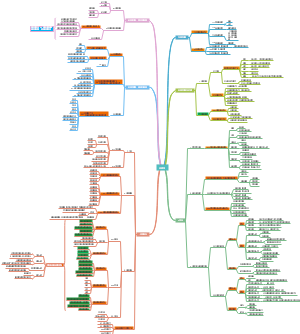导图社区 LABOR PRODUCTIVITY ANDCOMPARATIVE ADVANTAGE
- 23
- 1
- 0
- 举报
LABOR PRODUCTIVITY ANDCOMPARATIVE ADVANTAGE
we begin with a general introduction to the concept of compara- tive advantage and then proceed to develop a specific model of how comparative advantage determines the pattern of international trade.
编辑于2022-05-07 18:20:50- 大学经济学
- resources and trade
这是一篇关于resources and trade的思维导图,This model shows that comparative advantage is influenced by
- LABOR PRODUCTIVITY ANDCOMPARATIVE ADVANTAGE
we begin with a general introduction to the concept of compara- tive advantage and then proceed to develop a specific model of how comparative advantage determines the pattern of international trade.
- Consumer Choice and Demand
这是一篇关于Production and cost的思维导图,主要包括Types of Firms、Cost and Profit、Production、 Short-Run Production Cost、Long-Run Production Cost。
LABOR PRODUCTIVITY ANDCOMPARATIVE ADVANTAGE
社区模板帮助中心,点此进入>>
- resources and trade
这是一篇关于resources and trade的思维导图,This model shows that comparative advantage is influenced by
- LABOR PRODUCTIVITY ANDCOMPARATIVE ADVANTAGE
we begin with a general introduction to the concept of compara- tive advantage and then proceed to develop a specific model of how comparative advantage determines the pattern of international trade.
- Consumer Choice and Demand
这是一篇关于Production and cost的思维导图,主要包括Types of Firms、Cost and Profit、Production、 Short-Run Production Cost、Long-Run Production Cost。
- 相似推荐
- 大纲
Chapter Three—Labor Productivity and comparative advantage:The Ricardian model
proposed by British economist David Ricardo
Countries engage in international trade for two basic reasons
countries trade because they are different from each other
countries trade to achieve economies of scale in production
The Concept of Comparative Advantage
The reason that international trade produces this increase in world output
it allows each country to specialize in producing the good in which it has a comparative advantage.
A country has a comparative advantage in producing a good if the oppor- tunity cost of producing that good in terms of other goods is lower in that country than it is in other countries.
the world got smaller between 1840 and 1914
it got bigger again for much of the 20th century
essential insight about comparative advantage and international trade
Trade between two countries can benefit both countries if each country exports the goods in which it has a comparative advantage.
The Ricardian model
proposed by British economist David Ricardo
A One-Factor Economy
Home’s economy
summarized by
unit labor requirement
definition
labor productivity in each industry
the inverse of productivity
production possibility frontier
the different mixes of goods the economy can produce.
Production Possibilities
the limits on production
aLCQC + aLWQW </= L.
QW is the economy’s production of wine
QC its production of cheese
aLW as the unit labor requirements in wine production
aLC as the unit labor requirements in cheese production
The economy’s total resources are defined as L
the labor used in producing wine will be aLWQW the labor used in producing cheese will be aLCQC
Relative Prices and Supply
relative prices
definition
the price of one good in terms of the other
abor theory of value
definition
In the absence of international trade, the relative prices of goods are equal to their relative unit labor requirements.
Trade in a One-Factor World
the labor forces
the unit labor requirements
draw the production possibility frontier
Determining the Relative Price after Trade
determined by
supply and demand
partial equilibrium analysis
to study a single market, the sugar market
general equilibrium analysis
takes account of the linkages between the two markets
relative demand curve is indicated by RD; relative supply curve is indicated by RS
the normal result of trade
the price of a traded good relative to that of another good ends up somewhere in between its pretrade levels in the two countries.
The Gains from Trade
some ways to show that specialization and trade are beneficial
1. as an indirect method of production
2. examine how trade affects each country’s possibilities for consumption.
A Note on Relative Wages
the relative wage is between the relative productivities that each country ends up with a cost advantage in one good.
Misconceptions about Comparative Advantage
Productivity and Competitiveness
Myth 1: Free trade is beneficial only if your country is strong enough to stand up to foreign competition.
The Pauper Labor Argument
Myth 2: Foreign competition is unfair and hurts other countries when it is based on low wages.
Exploitation
Myth 3: Trade exploits a country and makes it worse off if its workers receive much lower wages than workers in other nations.
Comparative Advantage with Many Goods
Setting Up the Model
The technology of each country can be described by its unit labor requirement for each good
Relative Wages and Specialization
Determining the Relative Wage in the Multigood Model
The relative derived demand for Home labor will fall when the ratio of Home to Foreign wages rises,
two reasons
Home labor becomes more expen-sive relative to Foreign labor, goods produced in Home also become relatively more expensive, and world demand for these goods falls.
as Home wages rise, fewer goods will be produced in Home and more in Foreign, further reducing the demand for Home labor
Adding Transport Costs and Nontraded Goods
There are three main reasons why specialization in the real international economy is not this extreme:
1. The existence of more than one factor of production reduces the tendency toward specialization
2. Countries sometimes protect industries from foreign competition
3. It is costly to transport goods and services; in some cases the cost of transportationis enough to lead countries into self sufficiency in certain sectors.
Empirical Evidence on the Ricardian Model
that countries should tend to export those goods in which their productivity is relatively high
has been strongly confirmed by a number of studies over the years.









